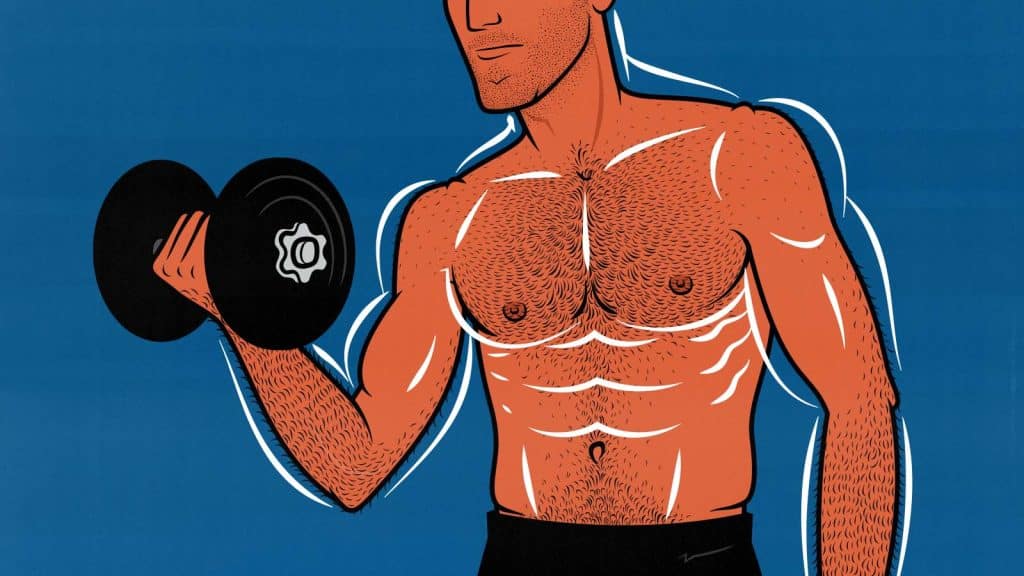
3-Day Full-Body Dumbbell Workout for Size, Strength & Aesthetics
This is a 3-day, full-body, dumbbell-only workout designed for building muscle. It’s perfect for beginners, but I’ll also give you more advanced dumbbell exercises you can swap in as you get stronger.
You can do the full workout routine with just a pair of adjustable dumbbells, but if you have a workout bench and pull-up bar, we’ll take advantage of those, too. If you don’t, I’ll show you how to train the same muscles with just dumbbells.
The workout is simple, but it’s deceptively effective. It follows all the same principles we’ve used to train college, professional, and Olympic athletes.
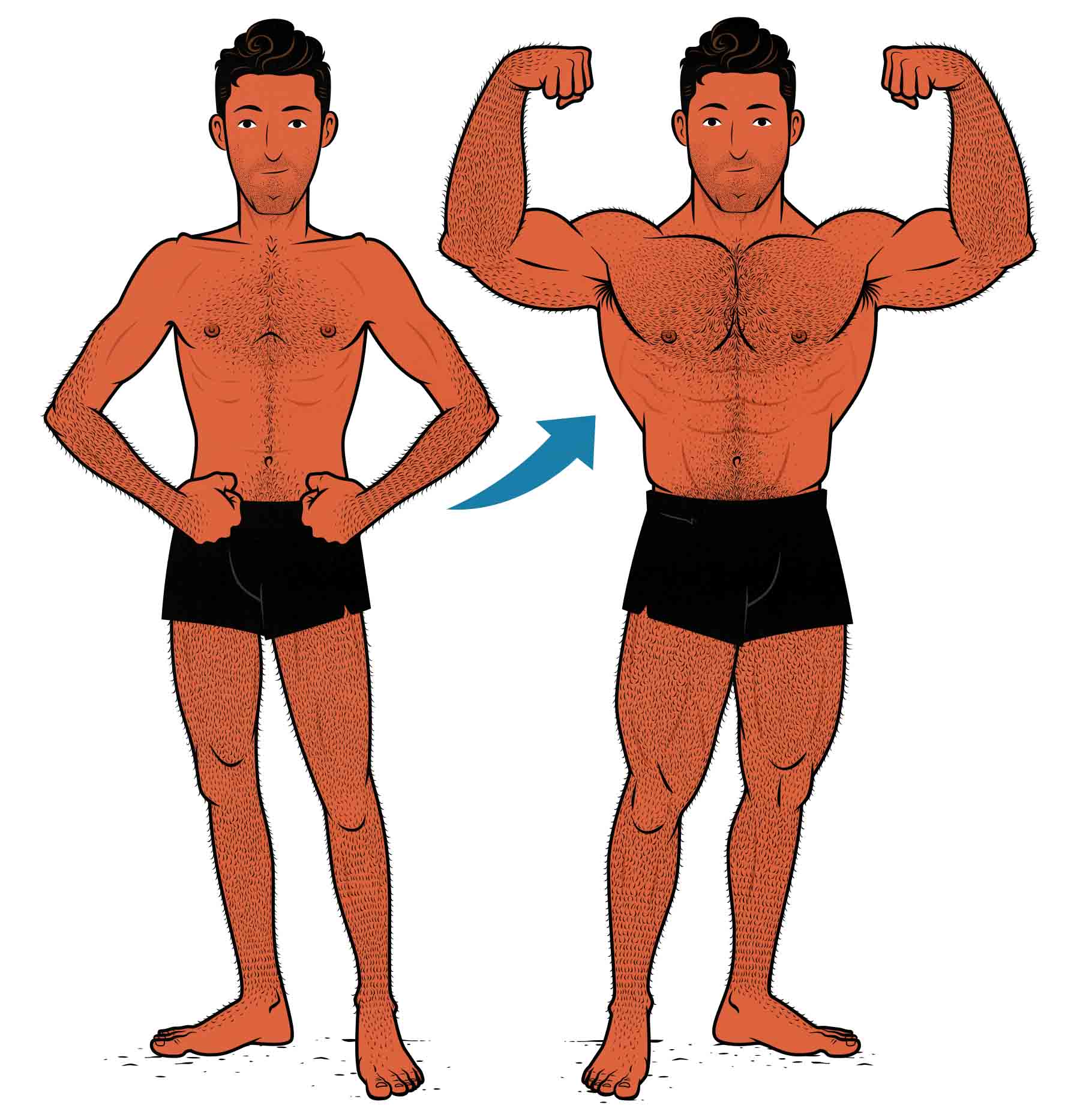
What Kind of Dumbbells Should You Get?
Whatever you have, we’ll make do. But ideally, you want dumbbells that can get gradually heavier. You could get a full rack of regular dumbbells, but that would be expensive and take up a ton of space. If you’re going that route, you’d probably build a full home gym.
What you probably want are adjustable dumbbells. You can order cheap ones on Amazon, maybe even get them second-hand. I’ve done that. I started lifting weights with a rusty pair of adjustable dumbbells I bought at a garage sale. That was perfectly fine.
You can also get much fancier adjustable dumbbells. They don’t rattle around, you can rest them on your knees, they don’t roll around on the floor, and it’s much faster to adjust the weights. The most famous ones are PowerBlock and Bowflex. Marco has this pair of PowerBlocks.
Video Walkthrough
I made a YouTube video to walk you through the workout routine. I explain all of the principles we’re using, demonstrate all of the exercises, and show you how to do the workouts. I’ll also explain everything in this article.
How to Do a Full-Body Workout Routine
The main idea of a 3-day, full-body workout routine is to keep your muscles growing steadily all week long. A challenging workout can stimulate muscle growth for 2–4 days, so if you’re training your muscles every 2–3 days, they’ll grow steadily all through the week. And indeed, most research shows that muscles grow faster when you train them at least twice per week (full explanation).
That gives you a routine that looks something like this:
- Monday: Full-Body Workout
- Tuesday: Rest
- Wednesday: Full-Body Workout
- Thursday: Rest
- Friday: Full-Body Workout
- Saturday: Rest
- Sunday: Rest Again
But the advantages go deeper. If you’re doing full-body workouts, you can do the very best dumbbell exercises every single time you train. You have the freedom to do what works best for you more often, to go harder after whatever your goals are.
If the exercise that’s best for growing your chest is the dumbbell bench press, push-up, or dumbbell fly—all great options—you can do that exercise 2–3 times per week. If your chest grows best from doing both dumbbell bench presses and flyes, you can do that combination 2–3 times per week.
You also get more practice. Lifting weights is a skill. The more often you practice, the faster your coordination improves. If you practice squatting, pressing, deadlifting, and pulling three times per week, you’ll get better at those movement patterns way faster than if you only practice them once per week.
Pairing the Exercises Into Supersets
If you want, you can pair the exercises into supersets, making your workouts healthier and more efficient. This will cut the length of your workouts in half and keep your heart rate higher, giving you some bonus fitness gains.
Supersets aren’t controversial. Nobody thinks they’re bad. Virtually every expert agrees they’re better. But they aren’t better for stimulating muscle growth, just for improving your workout efficiency and cardiorespiratory fitness. They don’t have any effect on muscle or strength gains. I recommend them, and I think you’ll like them, but they’re totally optional.

For example, the first two exercises are the dumbbell bench press and the dumbbell row. You can superset them together like this:
- Dumbbell Bench Press
- Rest a minute
- Dumbbell rows on the same bench, with the same dumbbells.
- Rest a minute
- Dumbbell Bench Press
- Rest a Minute
- Dumbbell Rows
We chose these exercises so that none of the muscles interfere with one another, and so that you don’t need to fiddle with adjusting the weights of your dumbbells.
The Workout Sheets
You’re free to write down the workouts however you like. Some people use workout tracking apps. Other people use pen and paper. You could jot it down in Google Docs or a notes app. All of that works.
But you do need to write down your workouts. You need to write down what exercises you’re doing, how much weight you’re lifting, and how many reps you’re getting each set.

Every time you repeat a workout, look at what you lifted last time and try to do a little bit better this time. That’s called progressive overload. It’s the quest to outlift yourself. It’s the heart of weight training.
My favourite way to record my workouts is with these workout spreadsheets. You can open them in any web browser or use the free Google Sheets app on your phone. They’re totally free, with no monthly fee. And they’re fully customizable.

We have the weeks right next to each other to make it easy to see what numbers you’re trying to beat. We want you thinking about progressive overload.
get the google spreadsheet of the
free beginner’s full-body workout
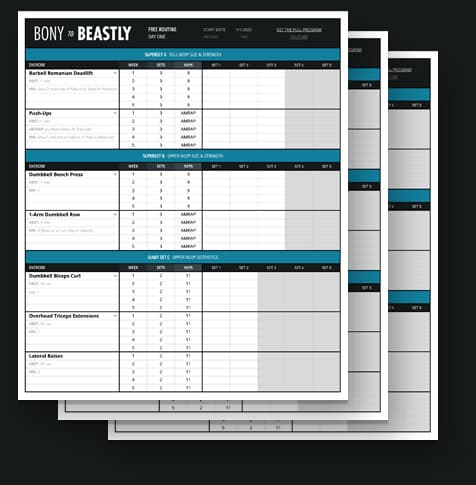
Get the workout as a Google spreadsheet. You’ll be able to pick from exercise alternatives, fill out the sheet, and get our beginner’s warm-up.
Plus, we’ll make sure you’re on the b2B newsletter, and send you all of our best muscle-building content.
The Workout Routine
Here’s a quick overview of the workout. All of this is in the workout sheets, but you can see the full workout routine here. All of the exercises link to our YouTube tutorial videos, where Marco will teach you the exercises. The workout sheets link to those same videos.
Workout One:
- Dumbbell Bench Press: 3 sets × 10 reps with 2 reps in reserve (2 RIR)
- Dumbbell Rows: 3 sets × As Many Reps As Possible (AMRAP)
- Dumbbell Romanian Deadlifts: 3×10 with 2–3 RIR
- Push-Ups: 3×AMRAP with 0–1 RIR
- Dumbbell Curls: 2×12 with 0 RIR
- Overhead Triceps Extensions: 2×AMRAP with 1 RIR
- Lateral Raises: 2×12 with 0 RIR
Workout Two:
- Goblet Squats: 3×10 with 1–2 RIR
- Dumbbell Pullovers: 3×10 with 0–2 RIR
- 1-Arm Dumbbell Overhead Press: 3×10 with 1–2 RIR
- 2-Point Dumbbell Rows: 3×10 with 0–1 RIR
- Front Planks: 2 sets for 5–10 slow breaths
- Side Planks: 2 sets for 5–10 slow breaths
- Dumbbell Farmer Carries: 2 sets of 40 steps
Workout Three:
- Goblet Squats: 3×10 with 1–2 RIR
- Dumbbell Pullovers: 3×10 with 0–2 RIR
- Dumbbell Romanian Deadlifts: 3×10 with 2–3 RIR
- Push-ups: 3×AMRAP with 0–1 RIR
- Hammer Curls: 2×12 with 0–1 RIR
- Triceps Extensions: 2×AMRAP with 1–2 RIR
- Lateral Raises: 2×12 with 0–1 RIR
The first four exercises make a good minimalist routine. If you want to keep your workout bare bones, that’s all you need for general health and solid muscle growth. The last 3 exercises give your arms, shoulders, and abs some extra isolation work.
I can also walk you through the workouts, explaining the exercises.
Workout One
First superset:
- Dumbbell Bench Press: 3 sets × 10 reps with 2 reps in reserve (2 RIR)
- Dumbbell Rows: 3 sets × As Many Reps As Possible (AMRAP)
The dumbbell bench press is perhaps the best chest exercise of all time. It’s great for getting a deep stretch on your pecs at the bottom of the range of motion, which is great for building muscle and improving your flexibility. It’s also good for your front delts and decent for your triceps. I recommend stopping 2 reps shy of failure (2 RIR).
Dumbbell rows are great for your lats and upper back, and they’ll bulk up your forearms, too. You can use the same bench and one of the dumbbells you used for the dumbbell bench press. Do as many reps as possible, going all the way to failure (0 RIR).
Second superset:
- Dumbbell Romanian Deadlifts: 3×10 with 2–3 RIR
- Push-Ups: 3×AMRAP with 0–1 RIR
All deadlift variations are great for your upper back, spinal erectors, and hips. Romanian deadlifts are best for your hamstrings, eliminating the need for a hamstring isolation exercise. When you get too strong for them, you can switch to kickstand Romanian deadlifts.
Push-ups are amazing for bulking up your chest, shoulders, and triceps. They’re also great for your abs and serratus muscles (under your armpits). If push-ups are too hard, raise your hands on a bench. If you can do more than 20, raise your feet up on a bench. When that’s too easy, try doing deficit push-ups by holding your dumbbells in your hands and sinking your chest down between them.
Third superset:
- Dumbbell Curls: 2×12 with 0 RIR
- Overhead Triceps Extensions: 2×AMRAP with 1 RIR
Dumbbell curls are for your biceps and/or brachialis muscles (which are right underneath your biceps). Overhead triceps extensions are one of the best exercises for your triceps. You can use the same dumbbells for both exercises.
Last exercise:
- Lateral Raises: 2×12 with 0 RIR
Lateral raises are for your side delts, which will make your shoulders broader.
If this workout feels too short or too easy, that’s okay for this week. Next week, you can add extra sets to some of the exercises. If you want to add another exercise to the end, that’s totally fine, too.
Workout Two
The first superset:
- Goblet Squats: 3×10 with 1–2 RIR
- Dumbbell Pullovers: 3×10 with 0–2 RIR
Goblet squats are the best squat variation for beginners, and it’s not even close. Holding the weight in front of you keeps your torso upright, allowing you to sink deeper and giving you a greater stretch on your quads. Holding the dumbbell in front of you also works your upper spinal erectors quite hard, giving you a thicker back and a stronger posture.
Pullovers are a great exercise for your lats, upper back, and triceps. Goblet squats only use one dumbbell, so you can set up your second dumbbell for pullovers.
The second superset:
- 1-Arm Dumbbell Overhead Press: 3×10 with 1–2 RIR
- 2-Point Dumbbell Rows: 3×10 with 0–1 RIR
This superset is one of my favourites. The dumbbell overhead press is great for bulking up your shoulders and traps, and doing one arm at a time makes it easier to lift with good posture. It also challenges some of your anti-rotational muscles.
The 2-point dumbbell row is a great back exercise, not just for your lats and upper back, but also for your spinal erectors and anti-rotational core muscles. And you’ll get some stimulus in your glutes and hamstrings, too.
The giant set:
- Front Planks: 2 sets for 5–10 slow breaths
- Side Planks: 2 sets for 5–10 slow breaths
- Dumbbell Farmer Carries: 2 sets of 40 steps
Planks are great for building the strength to keep a neutral spine while lifting, and they’re pretty good at stimulating your abs and obliques. Try to challenge yourself, but you don’t need to take your planks all the way to failure. You can think of them more like postural drills than bodybuilding exercises. You can do another ab exercise if you prefer.
Farmer carries are another great exercise for building a stronger posture. They’re also good for building a stronger grip and bulking up your upper traps. Choose a weight that’s excruciatingly difficult to hold by the time you finish your 40 steps.
You can do all three of these exercises as a “giant set”—a superset with 3 exercises—resting 20 seconds between each exercise.
Workout Three
The first superset:
- Goblet Squats: 3×10 with 1–2 RIR
- Dumbbell Pullovers: 3×10 with 0–2 RIR
You know this superset by now. Rest a minute between each exercise. Try adding more weight or getting more reps. Stop before failure on your goblet squats, but there’s no harm if you accidentally hit failure while trying to lift more than last time.
The second superset:
- Dumbbell Romanian Deadlifts: 3×10 with 2–3 RIR
- Push-ups: 3×AMRAP with 0–1 RIR
This is the same superset from the first workout, giving you more practice with Romanian deadlifts and push-ups. This will stimulate muscle growth throughout your entire body, strengthen your postural muscles, and give you a wide chest and a thick back.
The giant set:
- Hammer Curls: 2×12 with 0–1 RIR
- Triceps Extensions: 2×AMRAP with 1–2 RIR
This is very similar to the arm circuit from the first workout, but this time you’re holding the dumbbell with a neutral “hammer” grip while doing your biceps curls. Then throw that same weight overhead for your triceps extensions.
- Lateral Raises: 2×12 with 0–1 RIR
How to Choose the Right Weight
If a program tells you to start with a specific amount of weight, run away from it. At least that way, you’ll get some cardio in.
Everyone starts with a different amount of muscle and strength, so everyone needs to start with a different amount of weight. The only way to figure out what weight you should start with is through trial and error. And that’s good. It gives you some extra practice.
Grab a dumbbell you think you might be able to lift for 20–30 repetitions, but stop at 10. That will get some blood flowing and give you a bit of practice. You’ll also get a sense of how strong you are. Then grab a heavier dumbbell (or load more weight onto your adjustable dumbbell) and do another 10 reps. See how that feels.
Keep doing gradually heavier warm-up sets until you hit muscle failure at 8–12 reps. Muscle failure is when your posture collapses or muscles give out. Stop there. That’s your first real set.
Write down how much weight you lifted and how many reps you got. Rest for two minutes, and then do your second set. Write down how many reps you got.
When you repeat the workout, look at your workout sheet to see how much weight you lifted and how many reps you got. Your goal is to lift a slightly heavier weight or get slightly more reps than last time. You might not be able to, but it’s important to try. That’s the heart of gaining muscle and strength. Whatever happens, always write it down.
If I got 80×10 last week, this week I’m trying for 80×11 or 85×10. Either way, that shows progress. As a beginner, you should be able to gain strength fairly consistently from week to week.
Failure & Reps in Reserve (RIR)
In your first workout, I recommend taking some of your sets to muscular failure. If your posture crumbles, that’s failure. If you can’t move the weight anymore, that’s also failure. Lift until you can’t lift the weight with proper technique anymore. See where your limit is.
Once you’ve figured out where failure is and what it feels like, I recommend stopping just shy of it on most sets of most exercises. This is called leaving a Rep in Reserve—RIR for short. Most workout programs will have you lifting with 0–2 RIR instead of going to failure on every set. I’ve marked the recommended RIR on the workout sheets.
You can keep taking some sets to failure, though. The workout sheets will tell you which ones. There’s nothing wrong or dangerous with taking your last sets of push-ups, dumbbell rows, biceps curls, or lateral raises to failure. You’ll get practice pushing harder and stimulate some extra growth.
Most exercises will be limited by the strength of the muscles that are doing the lifting. Your biceps will fail when doing biceps curls. Your chest will fail when doing dumbbell bench presses.
But you may find that some exercises are limited by the strength of your postural muscles. Your abs may start to lose their position while doing push-ups. Your lower back muscles may start to round during dumbbell Romanian deadlifts. That’s failure of a different kind, but it’s still muscle failure, so stop the set when that happens. Next time, stop right before it happens.
It’s good to have a mix of both types of exercises. It isn’t bad that push-ups challenge your abs or that Romanian deadlifts challenge your spinal erectors. That’s half the purpose of those exercises. We want to bulk up your postural muscles, building postural strength.
Progressive Overload
There are two ways to progressively overload your exercises. Most beginners like to lift conservatively, stopping at 10 reps in earlier sets until they get 10 reps in all sets. Then they add a little bit of weight next week.
- Week 1: 50 pounds × 10, 10, 9
- Week 2: 50 pounds × 10, 10, 10
- Week 3: 55 pounds × 10, 8, 7
- Week 4: 55 pounds × 10, 10, 9
- Week 5: 55 pounds × 10, 10, 10
- Week 6: 60 pounds × 9, 8, 7
This is simple and works great. It keeps the earlier sets easier and the later sets harder. Great for building muscle. This is what I recommend to most beginners.
A more advanced option is to push hard on every set. Maybe that means getting 13 reps in the first set, 9 in the second, and 7 in the third. Again, you’d stick with the same weight until you get at least 10 reps in your final set. Like this:
- Week 1: 50 pounds × 12, 10, 8
- Week 2: 50 pounds × 13, 11, 10
- Week 3: 55 pounds × 10, 8, 7
- Week 4: 55 pounds × 11, 10, 9
- Week 5: 55 pounds × 12, 11, 10
- Week 6: 60 pounds × 9, 8, 7
If you do it this way, you’re leaving fewer reps in reserve in earlier sets, getting more tired, and hemorrhaging reps in later sets. It’s more stress and stimulus. That’s how I do my workouts.
The Muscle-Building Diet
For your diet, you have three paths to choose from:
- Bulking is the fastest and most reliable way to build muscle. It’s when you train for muscle growth, eat a nutritious muscle-building diet, and eat enough food to gain a little bit of weight on the scale each week.
- Cutting is the fastest and most reliable way to burn fat. It’s when you train for muscle growth, eat a balanced diet, and dip into a calorie deficit, forcing your body to get energy from your body fat.
- Recomping is when you try to build muscle and burn fat at the same time, usually without focusing on gaining or losing weight. It works best for people who are overweight, out of shape, and not in the habit of lifting weights.
Personal Support & Coaching
If you want us to walk you through a 5-month transformation, we have a full dumbbell muscle-building program with online coaching. The workouts are similar to these ones, but they’re periodized. You’ll advance you to a slightly different program every five weeks, finishing the full program in five months.
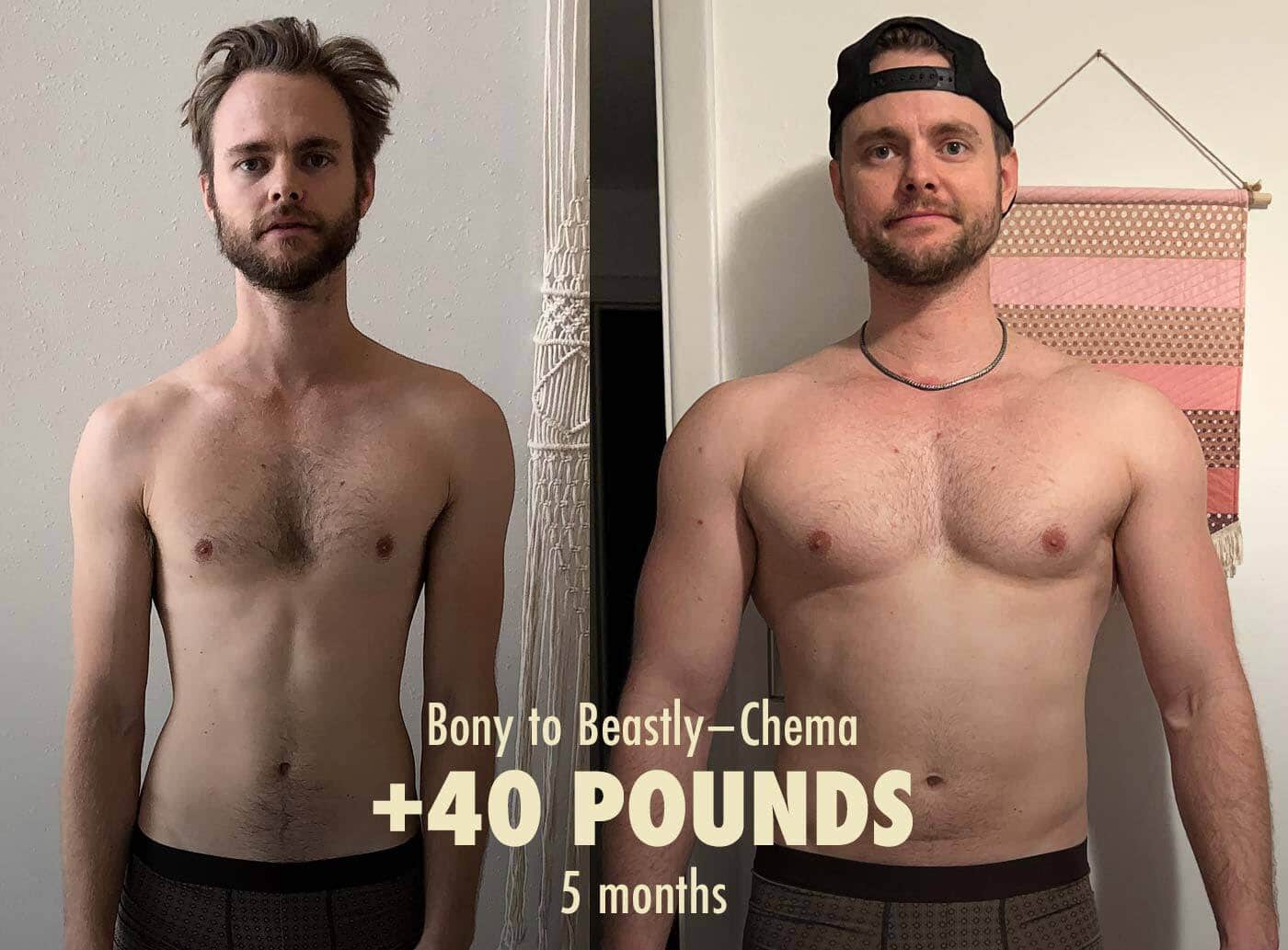
The program includes a lifting, diet, and lifestyle guide, sample meal plans you can get inspiration from (or follow verbatim), and a recipe book full of our best muscle-building meals.
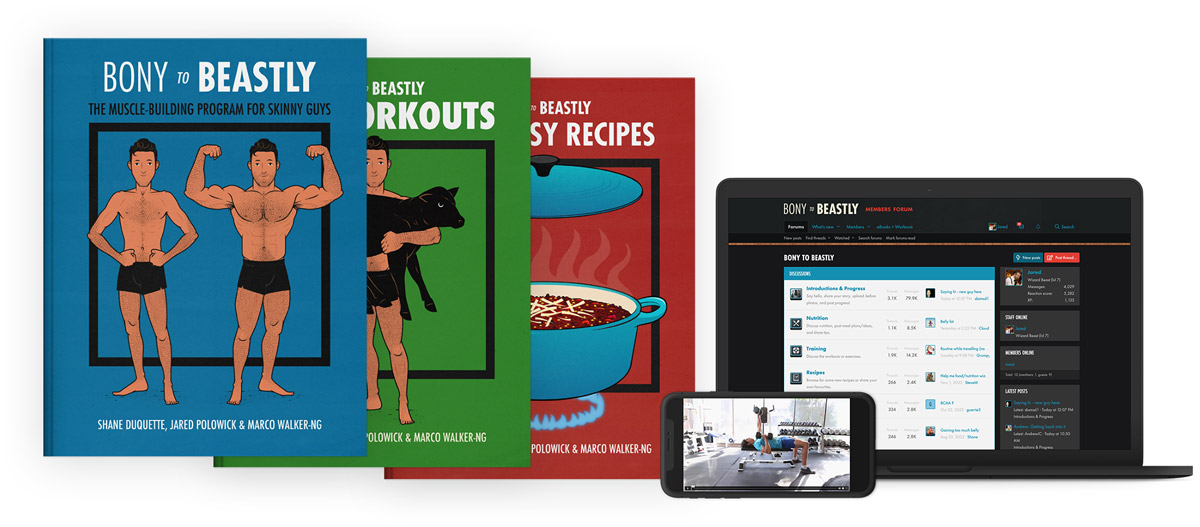
Perhaps most importantly, the program comes with personal support from us (including me). We’ll take a detailed look at where you’re starting, help you figure out the best place to start, adjust the plan as needed, help you track your progress, and give you feedback along the way.


Muscle-Building Mini-Course via Email
Sign up for our 5-part muscle-building mini-course that covers everything you need to know about:
Here are some related articles